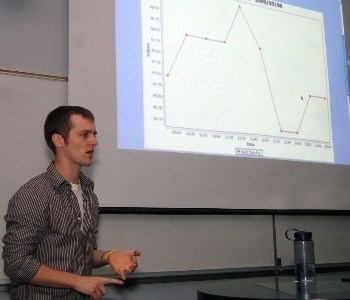Two-master graduate student’s new software could make a big splash for medical care, says a doctor with the Thunder Bay Regional Health Sciences Centre.
Lakehead University electric and computer engineering master’s students demonstrated their software at a news conference Wednesday. Luke Docksteader and Kris Scott focused their research on trying to make health care easier on both the doctor and patients.
Docksteader focused on remote patient monitoring utilizing a cell phone and broadband Internet connection to keep doctors informed and patients at home. Scott invented a program that connects a number of people to a single local server to collectively view and contribute to medical records.
Dr. Arnold Kim, lead hospitalist for Thunder Bay Regional Health Science Centre, said these two programs provided an opportunity to bring hospital care to the next level through modernization.
"The benefits from these programs are enormous," Kim said. "The software is about getting a large team on the same page. While current medical informative tools help us enormously, what’s change is we are facing an aging population with more comorbidity diseases, more issues to track and our increased team size."
Kim said a large team does need to collaborate on patient care but that isn’t always possible. A program that uses a collective server would keep health-care workers properly informed.
Both programs used Blackberries to access medical records and update doctors directly on patient maintenance.
Traditionally, patients drove to the hospital to receive check ups from healthcare workers.
Docksteader said his program focused on patients who lived outside of town or have recently discharged from a hospital. The mobile phone connects to a server at the hospital and accesses the medical records and then transfers that information back to the patient and doctor.
"Ideally the program would help people with chronic illnesses that doesn’t necessarily have to be at the hospital all the time," Docksteader said. "It gives them the freedom to go home and to live out their daily lives without having to live at the hospital."
Cell phone networks use base stations known as cell sites to bounce signals from a transistor to a phone.
Docksteader said there are limitations to how far a signal can reach, but added that he’s tried to work around it.
"With every system there are limitations," he said. "The system would only work in placed that do have coverage. As long as TbayTel and Rogers have coverage it will work fine."
Sign in or register
- Messages
- Post a Listing
- Your Listings
- Your Profile
- Your Subscriptions
- Your Likes
- Your Business
- Support Local News
- Payment History
Registered Users
Already have an account?
New Users
Create a free account.
